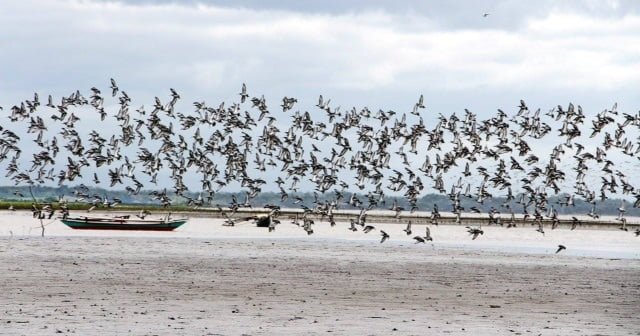
* Almost 80 species of migratory birds are found in the Negros Occidental Coastal Wetlands Conservation Area.
* The area covers 109.52 kms. in 10 towns and cities — all in southern Negros — from Bago to Ilog.
* The area is also home to terrestrial and aquatic wildlife species, including sea turtles and the Irrawaddy dolphin.
* At one single time, more than 20,000 waterbirds are found along the southern Negros Occidental coastline.
These were among the facts placed on spotlight when the Provincial Environment and Natural Resources Office in Negros Occidental marked the World Migratory Bird Day on Oct. 9.
The global event is observed twice annually, the other, early in May.
NOCWCA has been declared as the 7th Ramsar Site in the World and the 4th Asian – Australian Flyway Network Site. A Ramsar site is a wetland area designated to be of international importance under the Ramsar Convention on Wetlands, a treaty established by UNESCO in 1971. The treaty provides for both national and international action on the conservation of wetlands and the sustainable use of their resources.
World Migratory Bird Day this year focused on the theme, “Birds Connect Our World”, which highlights the importance of migratory birds in conserving and restoring the ecological connectivity and integrity of ecosystems.
The day also served as an awareness-raising campaign on the need to preserve migratory birds and their habitats. It also drew attention to the threats faced by these birds and on the need for international cooperation to conserve them.
NOCWCA covers Bago, Pulupandan, Valladolid, San Enrique, Pontevedra, Hinigaran, Binalbagan, Himamaylan, Kabankalan and Ilog. Terrestrial and marine wildlife in the area include the threatened species of marine mammals – the Irrawaddy Dolphins – and Green Sea, Olive Ridley and the Hawksbill sea turtles, which are also considered as threatened species.
Among the birds in the area are the endemic and threatened Philippine Ducks, the globally-significant population of Blacktailed godwits, Great Knots, Herons, Sandpipers, Egrets, Bitterns, and Stilts. NOCWCA also supports 1.5 percent of the global population of the endangered Great Knots and 2.1 percent of the near-threatened subspecies of Blacktailed Godwits.
NOCWCA serves as habitat for more than 20,000 waterbirds at a single given time, making it a crucial site for bird, conservation.
Activities conducted by PENRO on WMBD included an online media briefing, an online exhibit of NOCWCA information and education campaign, audio-visuals highlighting the significance of migratory birds as well as the production and distribution of printed materials.
“We are emphasizing the need for the public to help protect, manage and conserve the recognized wetlands in the province while we also emphasize the observance of health protocols in the fight against the coronavirus,” PENRO said.




